(For A Shorter Read Scroll Down To The BLUE FONT)
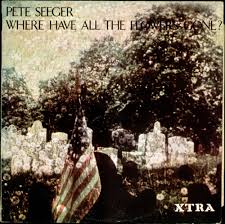
“Where have all the soldiers gone
Gone to graveyards, everyone
Oh, when will they ever learn?”
Ferment in the streets. College campuses ablaze with marches, demonstrations and sit-ins. It’s a blast from the past. In 1964, the first major demonstration against the Vietnam War erupted. Three years later, most Americans thought the Vietnam War was a mistake. The floodgates opened. Mass demonstrations began on college campuses, spilled out into the streets of major cities —New York, San Francisco, Berkeley, Oakland and D.C.
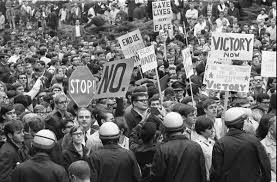 Horrors of the war aside, another important cultural shift was taking place. By the sixties, U.S. college enrollment had reached an all-time high of nine million. Baby Boomers, the generation that came of age in the sixties, were 76 million strong —26% of the population. The draft was an ever-present sword of Damocles hanging over the head of every male Boomer, hitting hardest at poor, minority men who couldn’t ride a college deferment out of the Vietnam maelstrom. Monthly draft totals reached 35,000 after the U.S. invaded Vietnam. Over three-quarters of a million students protested the Vietnam War at one time or another—on campuses and on the streets. The height and breadth of the outcry against the war in venues all across the U.S. qualifies this uprising as the most overwhelming display of civilian opposition to governmental excess up to that time.
Horrors of the war aside, another important cultural shift was taking place. By the sixties, U.S. college enrollment had reached an all-time high of nine million. Baby Boomers, the generation that came of age in the sixties, were 76 million strong —26% of the population. The draft was an ever-present sword of Damocles hanging over the head of every male Boomer, hitting hardest at poor, minority men who couldn’t ride a college deferment out of the Vietnam maelstrom. Monthly draft totals reached 35,000 after the U.S. invaded Vietnam. Over three-quarters of a million students protested the Vietnam War at one time or another—on campuses and on the streets. The height and breadth of the outcry against the war in venues all across the U.S. qualifies this uprising as the most overwhelming display of civilian opposition to governmental excess up to that time.
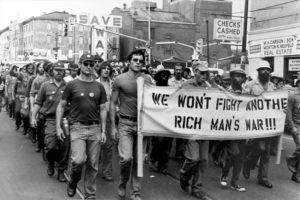 The war wasn’t the only indecency these rebellious students were protesting. Growing up in the conformity-laden fifties, barely out of diapers when the U.S. fought another imperialist, racist war against another nationalist movement in another country — Korea —a cadre of these young people came into the sixties determined to fight for a new ideology — anti-racist, anti-imperialist, anti-all the evils they had seen proliferate in the fifties.
The war wasn’t the only indecency these rebellious students were protesting. Growing up in the conformity-laden fifties, barely out of diapers when the U.S. fought another imperialist, racist war against another nationalist movement in another country — Korea —a cadre of these young people came into the sixties determined to fight for a new ideology — anti-racist, anti-imperialist, anti-all the evils they had seen proliferate in the fifties.
In 1967, two years after President Johnson’s announcement of a land war in Vietnam, 250,000 people took to the streets in New York and San Francisco in a coordinated march against the war. Six months later in October, 50,000 demonstrators stopped traffic at the Pentagon and rallied against a war that was killing their loved ones and the Vietnamese people.

The demonstration that catapulted opposition to the war into the headlines took place in August, 1968. The protesters were gathered at the site of the national Democratic presidential convention. LBJ had already announced that he would not run for a second term. It started out as something between a giant hippie picnic and a non-violent peace protest but morphed into something bigger and uglier courtesy of the Chicago police and their storm trooper tactics against the demonstrators. 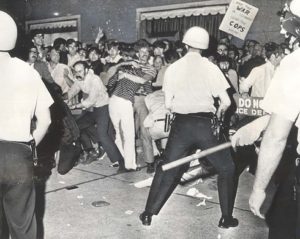 As the mayhem and brutality erupted, media attention followed it, broadcasting to a world-wide audience scenes of unimaginable brutality steps away from a national party convention. Millions of Americans sitting in front of their televisions swallowed hard as peaceful demonstrators assaulted by the cops turned the march into wide-spread rioting. To hardly anyone’s surprise, in November, Richard Nixon became the 37th President.
As the mayhem and brutality erupted, media attention followed it, broadcasting to a world-wide audience scenes of unimaginable brutality steps away from a national party convention. Millions of Americans sitting in front of their televisions swallowed hard as peaceful demonstrators assaulted by the cops turned the march into wide-spread rioting. To hardly anyone’s surprise, in November, Richard Nixon became the 37th President.
Thousands of protestors swelled into hundreds of thousands in 1969 and 1970, particularly as word leaked out that President Nixon and Henry Kissinger had moved the war into sovereign Cambodia: “He [Nixon] wants a massive bombing campaign in Cambodia. Anything that flies on anything that moves.” (Henry Kissinger to General Alexander Haig). The mother of all demonstrations occurred in 1971, 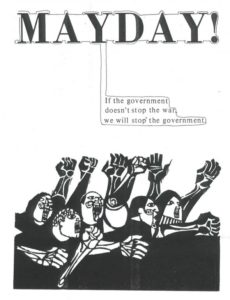 the three-day Mayday protest, when 35,000 protestors marched into D.C. What started as a peace march turned into a near-riot when Nixon panicked, canceled the march permit and sent in 10,000 heavily armed federal troops in addition to more than 5,000 local and park police. By the end of the third day, 7,000 protestors, a few tourists and a bevy of construction workers opposing the march were arrested. As CIA Director Richard Helms pointed out “[Mayday was] one of the things that was putting increasing pressure on the [Nixon] administration to try and find some way to get out of the war.” Which happened two years later as it became more and more obvious that a dedicated, no-surrender army of North Vietnamese peasant-soldiers was about to overwhelm the most expensive military in the world (in 1975 the North Vietnamese army marched into Saigon and completed the job).
the three-day Mayday protest, when 35,000 protestors marched into D.C. What started as a peace march turned into a near-riot when Nixon panicked, canceled the march permit and sent in 10,000 heavily armed federal troops in addition to more than 5,000 local and park police. By the end of the third day, 7,000 protestors, a few tourists and a bevy of construction workers opposing the march were arrested. As CIA Director Richard Helms pointed out “[Mayday was] one of the things that was putting increasing pressure on the [Nixon] administration to try and find some way to get out of the war.” Which happened two years later as it became more and more obvious that a dedicated, no-surrender army of North Vietnamese peasant-soldiers was about to overwhelm the most expensive military in the world (in 1975 the North Vietnamese army marched into Saigon and completed the job).
The protest era came to a grinding halt after Mayday. As a way of tamping down dissent, Nixon ordered the Selective Service to end monthly draft calls shortly after he was re-elected in 1973. By this time, much had changed on the ground. The boomers were in their thirties and determined to embrace middle class American values (buy, buy, buy). That wasn’t going to be as easy as it had been for previous generations. By 1972, interest rates were climbing (eventually reaching 20%), inflation topped 10%, and economic growth was non-existent. Jimmy Carter’s “malaise” speech reflected what most Americans were experiencing.
In 1990-1991, after the Clinton-era destruction of Yugoslavia that aroused little popular opposition (after all it was a Democratic president leading the charge), the U.S. war drums began beating again with Iraq in the cross hairs. This time it was a Republican administration that was leading the war effort. That was enough to galvanize the remaining anti-war groups into overdrive. Also reappearing were the age-old dispute over strategy and tactics. The two major movements — The Coalition to Stop U.S. Intervention in the Middle East and The National Campaign for Peace and Justice in the Mid-East took up where they had left off in the sixties. Family business slowed mass organizing.
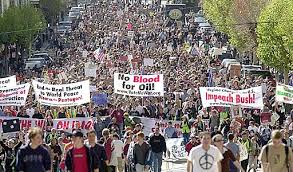 That changed on February 15, 2003, ten days after Secretary of State Colin Powell’s speech at the UN spinning the British and US intelligence agencies’ “high confidence” fraud that Saddam Hussein possessed WMDs. The whole world came together with a simple message—No to the Iraq War/ Not in Our Name”. It was the largest single coordinated protest in history: 12-14 million people in 600 cities all over the world — 3 million in Rome, 1 million in London and Barcelona, 200,000 in San Francisco, New York. After such a display of people power, even The New York Times, a reliable U.S. mouthpiece, commented “there are two superpowers: the U.S. and world public opinion.”
That changed on February 15, 2003, ten days after Secretary of State Colin Powell’s speech at the UN spinning the British and US intelligence agencies’ “high confidence” fraud that Saddam Hussein possessed WMDs. The whole world came together with a simple message—No to the Iraq War/ Not in Our Name”. It was the largest single coordinated protest in history: 12-14 million people in 600 cities all over the world — 3 million in Rome, 1 million in London and Barcelona, 200,000 in San Francisco, New York. After such a display of people power, even The New York Times, a reliable U.S. mouthpiece, commented “there are two superpowers: the U.S. and world public opinion.”
Less than two months later, on February 20, 2003, the U.S. began bombing Baghdad, an adventure that has cost over 100,000 Iraqi lives (the toll of the displaced into the millions) 4,864 American lives and well over a trillion U.S. dollars. A cautionary tale of hubris, poor planning and shocking incompetence.: “At this hour, American and coalition forces are in the early stages of military operations to disarm Iraq, to free its people and to defend the world from grave danger.” (President Bush televised address to the nation, March 19, 2003 in the U.S.).
After a world-wide protest of stunning proportions, the start of the war discouraged many. We were ignored…it obliterated political passion for my generation” (a millennial), “I was hugely optimistic that we could avert the war…nobody seemed to want it apart from Bush and Blair.” A 2017 ex-protestor — “Our demands were simple [in 2003] and we were right…when the war went ahead, nothing would ever be so simple again.”
***Quicker Read Start Here——>>>>
Today the anti-war movement is bedeviled by competing visions, the same old arguments over strategy and policy, squabbles over what to protest. Two national networks present starkly different recipes for success. ANSWER (Act Now to Stop War and Racism) wants their anti-war main course sitting on a bed of opposition— to U.S. imperialism, to U.S. sanctions spread liberally across the Mid-East, and to the Israeli occupation of Palestine. On the other hand, the UFPJ (United for Peace and Justice) is a step-child of the Democratic party, with wealthy and influential godfathers (and godmothers) arguing for more and bigger sanctions on more and more countries, championing everything Israel, and mum on the subject of U.S. imperialism.
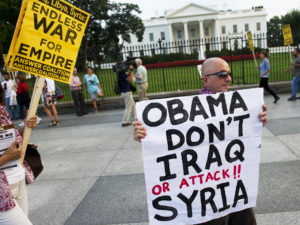 What emerged from these rivalries was a “safe” anti-war movement that ruffled few important feathers, attacked the Republican war policy (mostly because the U.S. had once again lost a war) and “foamed the runway” for Obama’s victory in 2008. Once Obama won and the Democrats were back in power, everything was peachy and anti-war agitation no longer mattered nor was it encouraged. The notion that the only way to end war is to oppose the imperial foreign policy of the world’s sole superpower was quickly debunked. After all, Obama could hardly be called an imperialist. When he invaded countries, laid waste their infrastructure, displaced their citizens (the ones that didn’t die after a U.S. drone hit) and sent their (sometimes) democratically elected leaders running for the exits or dead, it was a humanitarian mission, the much abused “responsibility to protect (R2P)” From the plains of Afghanistan (thanks, Carter) to the Balkans in eastern Europe (let’s hear it for Clinton) to Africa (Ahoy, Obama), Democratic presidents have R2Ped the U.S. military over a wide swathe of planet earth. And the anti-war movement has been mostly MIA.
What emerged from these rivalries was a “safe” anti-war movement that ruffled few important feathers, attacked the Republican war policy (mostly because the U.S. had once again lost a war) and “foamed the runway” for Obama’s victory in 2008. Once Obama won and the Democrats were back in power, everything was peachy and anti-war agitation no longer mattered nor was it encouraged. The notion that the only way to end war is to oppose the imperial foreign policy of the world’s sole superpower was quickly debunked. After all, Obama could hardly be called an imperialist. When he invaded countries, laid waste their infrastructure, displaced their citizens (the ones that didn’t die after a U.S. drone hit) and sent their (sometimes) democratically elected leaders running for the exits or dead, it was a humanitarian mission, the much abused “responsibility to protect (R2P)” From the plains of Afghanistan (thanks, Carter) to the Balkans in eastern Europe (let’s hear it for Clinton) to Africa (Ahoy, Obama), Democratic presidents have R2Ped the U.S. military over a wide swathe of planet earth. And the anti-war movement has been mostly MIA.
As the Obama “glow” fades and the Trump miasma closes in, whither the anti-war movement? Starting with Obama and dribbling into Trump, protest has been replaced by symbolic gestures—flag salutes, mindless recitations of the Pledge of Allegiance, rapt attention to vocal renditions of The Star- Spangled Banner and America the Beautiful — government-inspired gestures that are a distraction not an exercise of citizenship. Meanwhile back at Mar-a-Lago, Trump is ramping up high-profile military attacks. As early as January, U.S. special forces raided an Al Qaeda compound in Yemen killing a navy seal and several civilians. Two months later, an airstrike over Iraq, using inaccurate information from our rebel “friends,” went sadly awry killing over a hundred civilians —an object lesson in how to make friends and influence (Iraqi) citizens. April’s gift to humanity was the firing of 69 Tomahawk missiles at a Syrian airfield in retaliation for a chemical attack that might have been carried out by the Syrian government or U.S. supported “freedom fighters.” Next up was a bombing raid on pro-Syrian forces on the “trumped-up” charge that Syrian planes were getting too close to U.S. backed forces. Our actions and those of our Iraqi 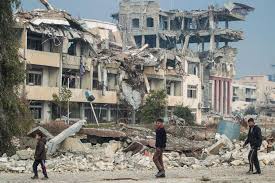 “partners” liberating Mosul has been called a war crime by Amnesty International. The number of U.S. forces in the Mid-East —primarily Special Forces assassination squads — has been rising steadily since the Republicans came into power. Trump’s policy on troop escalation in the Mid-East and other trouble spots (think Africa)— “We have the greatest military in the world… We have given them total authorization…that’s why they’ve been so successful lately.”
“partners” liberating Mosul has been called a war crime by Amnesty International. The number of U.S. forces in the Mid-East —primarily Special Forces assassination squads — has been rising steadily since the Republicans came into power. Trump’s policy on troop escalation in the Mid-East and other trouble spots (think Africa)— “We have the greatest military in the world… We have given them total authorization…that’s why they’ve been so successful lately.”
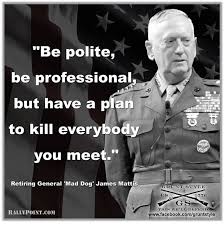 Trump has thus ceded civilian control of the military to the military brass in the Pentagon, and the Secretary of Defense, retired marine General James Mattis, whose self-described mission is to “elevate the role of the U.S. military in the world.” If anyone can do it, bet on this buccaneer. Here he is in Iraq in 2003 giving a pep talk to marines “Be polite, be professional but have a plan to kill everyone you meet.” This is the “good” general enthusing in 2005 “…it’s a hell of a lot of fun to shoot them (Afghanis)…it’s fun to shoot some people. I’ll be right up there with you. I like brawling” [Apparently, this last quote is the Mattis RX for raising troop morale]
Trump has thus ceded civilian control of the military to the military brass in the Pentagon, and the Secretary of Defense, retired marine General James Mattis, whose self-described mission is to “elevate the role of the U.S. military in the world.” If anyone can do it, bet on this buccaneer. Here he is in Iraq in 2003 giving a pep talk to marines “Be polite, be professional but have a plan to kill everyone you meet.” This is the “good” general enthusing in 2005 “…it’s a hell of a lot of fun to shoot them (Afghanis)…it’s fun to shoot some people. I’ll be right up there with you. I like brawling” [Apparently, this last quote is the Mattis RX for raising troop morale]
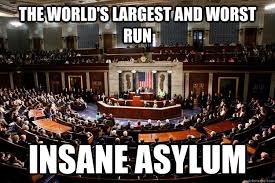 Will anything stop the madness? All eyes turn to Congress. What’s up with them? They’re sitting on their collective duffs, fists raised vowing action — not against the perpetual war that is sapping America’s strength, vitiating human and natural resources, dimming the democracy we spend so much time proclaiming, and punishing the most vulnerable overseas and at home— but against an unproven (and probably over-hyped) Russian plot to steal the election for Trump and destroy our democracy (as if we weren’t doing a pretty good job of that without any help). Oh, and by the way they are also going to get to the bottom of the “treasonous” behavior of Trump’s minions.
Will anything stop the madness? All eyes turn to Congress. What’s up with them? They’re sitting on their collective duffs, fists raised vowing action — not against the perpetual war that is sapping America’s strength, vitiating human and natural resources, dimming the democracy we spend so much time proclaiming, and punishing the most vulnerable overseas and at home— but against an unproven (and probably over-hyped) Russian plot to steal the election for Trump and destroy our democracy (as if we weren’t doing a pretty good job of that without any help). Oh, and by the way they are also going to get to the bottom of the “treasonous” behavior of Trump’s minions.
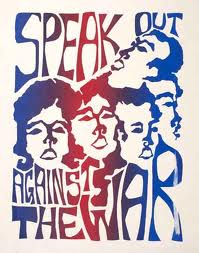 Many obstacles stand in the way of a 21st century anti-war movement. Perhaps the biggest and least appreciated is the simplest to understand. “There is no substitute for mass mobilization in the streets…to get that takes getting to youth, many of whom remember nothing at all pre-Bush [and Obama]; their world is one of permanent war with no boundaries.” (Debra Sweet, National Director “The World Can’t Wait”).
Many obstacles stand in the way of a 21st century anti-war movement. Perhaps the biggest and least appreciated is the simplest to understand. “There is no substitute for mass mobilization in the streets…to get that takes getting to youth, many of whom remember nothing at all pre-Bush [and Obama]; their world is one of permanent war with no boundaries.” (Debra Sweet, National Director “The World Can’t Wait”).
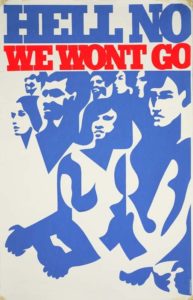 Hard to make believers out of young people whose only reality is war.
Hard to make believers out of young people whose only reality is war.
COMING MONDAY: a deeper look into the connection between the disappearance of the anti-war movement and the disaffection of young people.
801 total views, 1 views today
